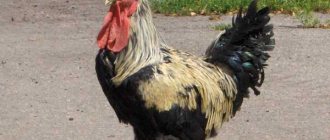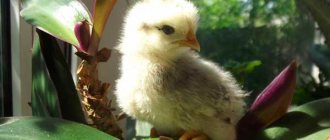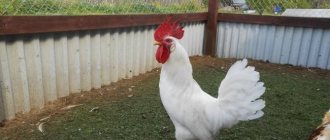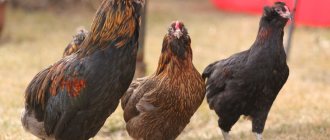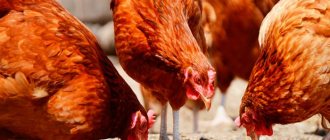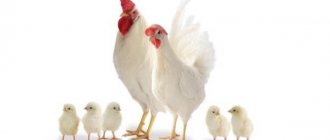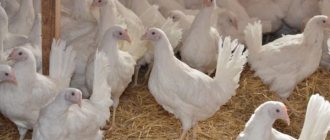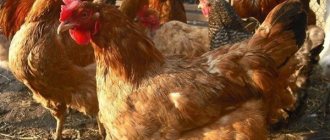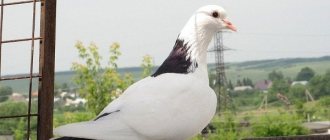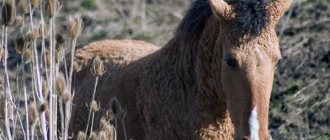The climate conditions on our planet change every year. Birds, like all plants, are also sensitive to change. If earlier one breed perfectly adapted to the conditions of a certain region, now adaptation occurs with difficulty. Breeders faced a new challenge related to breeding chickens that quickly take root in any climate. Ukrainian scientists managed to obtain one of these breeds in 2005. Curious poultry farmers began to wonder what kind of Borkovsky Barvisty chickens they are, what is the peculiarity of proper care and maintenance, because today the bird has not yet become widespread.
Historical information about the breed
This is a still little-known new breed from Ukrainian breeders, which was obtained in 2005. They crossed egg breeds of chickens - colored and white, very popular among poultry farmers, Leghorns. These hens have inherited high egg production rates from their parents.
A big advantage is also that the bird is not a hybrid, which means it can be propagated independently without any problems. At the same time, the positive characteristics of the bird are not lost.
It got its name from the location of the poultry farming institute where it was obtained - in the village of Borki, located near Kharkov. The second name comes from the Ukrainian word “barva”, which translates as “color”.
Poultry conformation and standards
Representatives of the breed are not impressive in size. These are small chickens weighing 2.1 kg, the average weight of a rooster is 2.7 kg.
The main breed standards include:
- Head. The bird is small, has a red face, and orange eyes.
- Beak. Slightly curved, grayish with a yellow tint.
- Crest. Bright red color (pinkish tint is allowed) and leaf-shaped. Males have up to 8 long teeth on it, while females have them of a more modest size.
- Body. Thin boned, strong. The skin is yellowish. The back is flat. The rooster's belly is tucked up, its chest is like a wheel; In laying hens the abdomen is well developed.
- Wings. Small, well pressed to the body. The feathers are hard and dense, there is little fluff.
- Tail. Set on high, long and bushy. Dark spots are visible on the tail feathers.
- Paws . The paws are of average length, they are yellow without feathers.
This breed is characterized by a cuckoo coloration. Females and males can be distinguished already at a young age. Chickens are characterized by a darker color. However, the color becomes lighter towards the bottom. In many representatives, the feathers on the belly may be white, but feathers with a light red tint are also allowed. Now you can find Barkov chickens with white, red or red coloring.
To obtain offspring do not use:
- roosters with a solid collar;
- with a small comb and earrings.
Detailed description of the breed with photos
Laying hens of Ukrainian selection have an attractive appearance. The main decoration of the bird is its motley cuckoo-colored plumage. The feathers on the rooster's chest are snow-white. The bushy tail is raised high and has a crescent shape.
Borkovsky breed hen and rooster
The physique of representatives of the Borkovskaya Barvistaya breed is typical for egg-laying chickens - light bones, compact, fit body, light weight. The weight of a one-year-old rooster rarely exceeds 2.7 kg, and that of a laying hen - 2 kg.
Exterior Features
The photo shows a Borkovskaya Barvistaya breed rooster. Description of exterior features:
- medium-sized head with a bright red face and orange eyes;
- earlobes are oval, white;
- earrings are long, bright red;
- the neck is short, wide;
- the comb is large, leaf-shaped, with 6–8 sharp teeth;
- the chest is rounded, raised;
- tucked stomach;
- the back line is straight;
- legs of medium length, metatarsus unfeathered, yellow;
- the wings are small, tightly pressed to the body;
- the tail is sickle-shaped, long, rather bushy.
Livestock of Borkovsky barvy chickens
Laying hens have a small crest, a rounded belly, and a short tail raised at 45 degrees. Hens are smaller than roosters, and their color is more intense. The feathers on the breast and belly of females always have a lighter shade than those on the neck and back.
Reference. Borkovsky chickens have not only cuckoo colors. There are representatives of this breed with white or red feathers.
The following are considered unacceptable deviations from the standard:
- an underdeveloped ridge or one that falls to one side;
- the presence of a continuous collar around the neck;
- small earrings.
Bird productivity
Leghorn descendants are slightly inferior to the parent line in terms of egg production. During the year, laying hens produce about 250–265 eggs with beige shells. The average weight of a unit of product is 60 g, but many farmers say that the weight of eggs from Borkovsky barvy chickens sometimes reaches 65–70 g.
Borkovskaya chicken eggs
The pullets mature early, at 4 months. The most intense egg laying occurs at the age of 7–8 months. There is little meat on the carcasses; it is not suitable for frying and baking due to its toughness. Young roosters are sometimes used to prepare dietary broth.
Attention! Borkovsky chickens are highly resilient. Those that are naturally bred and raised by a brood hen survive 96% of the time. Among chicks hatched in an incubator, 10 out of 100 die in the first week of life.
Character of birds
Farmers who happen to keep chickens of the Borkovsky barvy breed claim that laying hens are peaceful, but overly timid. They are not afraid of their owner, but run away from strangers. The birds are quite noisy, active, and curious.
Among the roosters there are both calm and cocky individuals. Conflicts often arise between males, ending in injuries and wounds. Experienced poultry farmers recommend culling aggressive flock members so that the bad trait is not passed on to offspring.
Maternal instinct
Among chickens of egg breeds, good brood hens are rare. Borkovskaya barvistaya is an exception to the rule. The birds have retained the instinct of incubation and the ability to care for offspring. Those who want to breed representatives of the Ukrainian line in their yard will not need an incubator.
Borkovsky chickens are good hens
To get chickens, you will have to select several of the best hens and use them for reproduction. The remaining laying hens will perform their main function - to provide the owner with a large number of eggs.
How does molting affect egg production?
Seasonal feather change occurs at the end of September - beginning of October and lasts 2 months. During this period of time, chickens lay eggs less often. This is normal, there is no reason to panic. When a bird molts, its body uses most of its nutrients to form new feathers.
Attention! Molting is always accompanied by a weakening of the immune system. The farmer must protect the laying hens during this period from drafts and hypothermia and introduce vitamin and mineral supplements into their diet, for example Chiktonik or its analogues. The duration of the preventive course is 2 weeks.
Productive Features
Borkov barvy chickens are representatives of the egg breed. They begin to lay eggs early - from 4 months of age. You can get up to 265 eggs from them per year. The highest egg production is observed in the 7-8th month of life. The high rate lasts up to 2-2.5 years, then it gradually begins to decline.
The weight of one egg laid by a pullet does not exceed 53 g; by the year its weight reaches 59 g. However, some owners claim that the weight of the egg can reach up to 65 g. The shell of the eggs is cream or light brown. The taste is excellent.
Despite their small live weight, their meat is dietary and tasty. By two months, chickens weigh an average of 1.2 kg.
For an overview of this breed of chicken, see the video below:
Puberty and egg production
Chickens of the Borkovskaya Barvista breed are popular due to their high fertility, in the professional language of bird breeders called egg production. Starting from 4.5–5 months of age, chickens of this breed already begin to lay eggs. The number of eggs per year from one chicken can reach 265 pieces. However, after two years their productivity begins to decline. This circumstance must be taken into account to maintain the fertility of the bird flock at a high level. It is recommended to replace two-year-old females in time with young laying hens.
Barvista chickens lay high-quality eggs
The viability of the chicks hatched by the hen reaches 95%. Chickens raised in an incubator have a 2–6% lower survival rate. Eggs weighing up to 65 g have light beige shells. The breed produces delicious chicken, so farms also buy these chickens for meat.
Table 2. Productivity.
| Age of sexual maturity, months. | 4,5 |
| Number of eggs per year from one female, pcs. | 255–265 |
| Age of decline in productivity, years | 2 |
| Egg weight, g | 55–65 |
| Chick survival rate, % | 95 |
| Weight of adult chickens, kg | 1,7–1,9 |
| Weight of adult roosters, kg | 2.4–2.5 kg |
Temperament and maternal instinct
Laying hens have a calm and friendly character, but are quite shy. They quickly get used to their owner and do not run away from him.
Information about cockerels varies. Some owners claim that they have a peaceful disposition. Others note aggressiveness; often conflicts turn into fights, the outcome of which can be the murder of an opponent. Aggressive individuals should be immediately sent to the soup.
Experts explain this contradiction by the fact that the breed is quite young and has not had time to form. If pugnacious roosters are not used for breeding, then the aggressiveness will soon disappear.
Borkovsky Barvis hens make excellent brood hens. Eggs from other chicken breeds are often placed next to them. The viability of offspring hatched by a hen is up to 96%; from an incubator it is lower (about 90%).
Character
For most poultry farmers, the character of the chicken in question seems ideal. Firstly, the Borkovskaya Barvistaya breed of chickens is extremely smart and quick-witted, like a talking bird. Secondly, the bird is calm and accommodating, has no tendency to conflict, and easily accepts the proximity of representatives of other species.
But the excellent quonka has one peculiarity - it is a big fan of creating noise out of nothing. The roosters are vocal and melodious, and the black clowns happily echo them with their clucking. During walks in the yard, the herd practically never stops talking, except during feeding.
Pros and cons of the breed
The advantages of the breed include:
- high immunity;
- autosexity, that is, the possibility of separating chickens by sex (by down color) at one day of age;
- excellent maternal instinct;
- high hatching rate of chicks;
- their high survival rate;
- good adaptability;
- frost resistance of poultry.
The disadvantages include:
- aggressiveness of roosters;
- average egg production compared to egg crosses.
About the advantages and disadvantages
To summarize, we can say that the Borkovsky breed is a real storehouse of pleasant character traits and productivity. The main advantages of birds include:
- frost and stress resistance;
- developed maternal instinct;
- good and high egg production and productivity;
- balance and unpretentiousness;
- having good health;
- possibility of year-round egg production;
- activity.
As years of communication between farmers and chickens of the breed have proven, it is almost impossible to find shortcomings, because even vocality can easily get used to. In general, Barvy chickens are the best choice for home or commercial breeding.
The Barvy breed of chickens is a true example of how all birds should behave. In addition to incredible productive qualities, chickens of this breed amaze with their docile character and attractive appearance. The description and characteristics of the individuals once again prove that breeding Barvis chickens is the right and interesting decision. If you are interested in the true Borkovskaya chicken breed, remember, you will not be mistaken in your choice.
Bird keeping
Chickens of this breed are easy to care for. They quickly adapt to new conditions and tolerate frost well.
Chicken coop
The room for chickens should be dry, bright and ventilated, as, indeed, for all poultry. Except that for them, perches can be placed at a height of not only 0.7-0.8 m from the floor, but also much higher. The flight abilities of chickens in this case are a big plus - this allows you to save space in the poultry house. How to organize roosts in a chicken coop is described here.
For the winter, the chicken house is insulated. The room temperature should be above zero all the time. It is enough to insulate only the walls and floor; heaters are not installed.
The main condition is the absence of drafts. If the bird can still withstand frost, then the blowing wind in the room will negatively affect its health. A deep bedding is placed on the floor, which is changed regularly to avoid the development of infectious diseases.
Be sure to provide baths with ash or sand for bathing. In this case, the chickens will not suffer from the invasion of external parasites.
Daylight hours are extended in the autumn-winter period with the help of additional lighting. The optimal length of the day should be 12-14 hours, then the hen will lay eggs even in the cold season.
How to build a chicken coop with your own hands according to all the requirements - read in our other article.
Walking yard, feeders and drinking bowls
When building a walking yard for them, it is worth keeping in mind that they have strong wings and are able to fly. Therefore, they either make high fences over which they cannot fly, or cover the top of the enclosure with a net.
This small bird loves to rake food with its paws. Thanks to its modest size, it even manages to climb into special feeders, the structure of which should prevent birds from getting inside it. Therefore, it is better for them to purchase models of feeders with holes only for the head.
How to make your own feeder is described in detail here.
Features of care and maintenance
The productivity of this breed of chicken directly depends on the conditions and quality of maintenance.
Place of detention
For Legbar chickens, it is better to build a chicken coop from scratch rather than using an old barn. Birds are very demanding when it comes to their living conditions, so you shouldn’t skimp on this.
Recommendations for poultry house equipment:
- The poultry house should be located on a hill so that groundwater does not flow into it.
- It is recommended to use bacterial bedding for the chicken coop.
- Inside the chicken coop, perches made of timber with round edges are installed. Each female should have approximately 0.3 m of pole. The height of the perches is 1 m from the ground, the distance between the poles is 0.5 m.
- Nests for females are located at a height of 0.8 m from the ground. For this purpose, you can use simple boxes measuring 0.4 * 0.4 m. Straw or hay is placed inside, which serves as a warm bedding; it should be changed periodically.
The Legbar chicken breed is very active, so you can’t do without a walking yard. It is built next to the chicken coop, and is fenced with chain-link around the entire perimeter so that the birds cannot fly away. It is better to cover the top of the walking yard with a small but reliable roof, this way you will protect the chickens from heavy rain, the burning sun and wild birds.
Watch a video about the characteristics of the Lekbar chicken breed, how to properly maintain and care for them:
Temperature, lighting, humidity
The bird loves warmth very much, so the chicken coop should be heated all year round. The best temperature indicator is +15 degrees Celsius. In winter, the poultry house is insulated or heated, otherwise egg production will drop, and some females even die. It is better to install heaters and insulate the floor well with straw, hay or peat.
Cleanliness and dryness are two more important factors in keeping poultry well. Change the litter 2 times a month, clean and ventilate the room. As for chicken droppings, it contains a small proportion of ammonia, which harms not only the respiratory system of birds, but also the gastrointestinal tract.
Illumination in the poultry house is also important; there must be windows to allow natural sunlight to penetrate; in autumn and winter, additional lighting is installed in the room.
Diet and feeding rules
Chickens are demanding on their diet; the presence of all important nutritional components is the key to high productivity. The usual menu, consisting of feed and grain mixtures, is not suitable for birds.
To feed this breed, you need to create or buy special food. This is a balanced blue food. You can buy similar food at the poultry market; it contains all the necessary elements for Legbar.
You can make Legbar feeding mixture with your own hands; it consists of the following components:
- a couple of types of crushed grain;
- cake;
- roots;
- meat and bone meal or fish meal;
- dried grass;
- special supplements and vitamins.
Vitamin complexes are added to the feed to increase egg production. But you cannot exceed the permissible norm, otherwise it will lead to vitamin deficiency and complete depletion of the body. The chicken coop should always have drinking bowls with clean water. It is also useful to place baths with shells or fine gravel.
Poultry farmers claim that occasionally there are moments when some individuals peck at others - this is due to a lack of vitamins and minerals. Vitamins C play a special role in Legbar’s body; experts recommend purchasing the drug Pentavit, which can provide chickens with all the necessary components.
Shedding and care in winter
Molting is a common phenomenon; there is no need to be afraid of it; on the contrary, birds should be helped during this difficult period for them. Shedding helps improve health and increase productivity. This phenomenon may be delayed in its manifestation if you provide the birds with too long daylight hours.
If the molting is delayed, then you need to contact a veterinarian who will help to induce it artificially. During this period of time, chickens do not lay eggs.
The winter season of the year is the most difficult period. Birds freeze and die. The poultry farmer must take care of the laying hens, keep them in a heated room, avoid drafts and provide adequate nutrition. In winter, minerals and vitamins are added to the menu, which help protect chickens from various diseases.
Feeding ration
The diet of adults and chicks differs, so nutrition is organized differently.
Adults
The main food product of adults is grain. It should provide the bird with all the necessary vital nutrients. Experts recommend using grain mixtures made from wheat, oats, corn and rye or using industrial feed consisting of a mixture of grains. In summer, part of the grain is replaced with greens - fresh grass. For large livestock it is easier to cut it using a special chopper.
In winter, especially laying hens, need vitamins. Their main source is fresh vegetables. If it is not possible to provide the livestock with vegetables or grass, then vitamin complexes are added to the diet, which can be purchased in specialized stores.
How to increase the egg production of laying hens in winter is described in this article.
For a strong shell, calcium is added to the diet. Birds should always have a container with shell rock, crushed shells or chalk in the room. A plate with small pebbles is placed nearby for normal functioning of the digestive system.
A sippy cup with clean water should always be freely available. In hot weather, the need for fluid increases. You can make a suitable drinking bowl for chickens yourself. How to do this - read here.
Chicks
In order for the chicks to quickly gain weight and grow well, they follow a diet. For the first 7 days of life, they are fed every 3 hours - during the day they eat 6 times.
The food must be crushed and prepared into crumbs. The chicken should swallow it without difficulty. In the first 3 days they are fed with crushed boiled eggs, then boiled cereals and greens are included. To enrich food with vitamins, fish oil, cottage cheese, yogurt and yeast are added. Next, vegetables and feed are introduced.
At 1 month, young animals are offered “live” food - maggots, insects. From 1.5 months they feed with the main herd. But as they continue to gain muscle mass, they are given more proteins, vitamins and minerals.
Breeding chickens
Raising chickens does not cause any difficulties. The hen copes with her duties “excellently”; you can also use an incubator to produce chicks. Healthy chickens that meet breed standards are selected for breeding. One rooster is left for 10 females.
Grown-up chicks are kept separately by sex, as roosters can be pugnacious and require more feed.
Reviews from breeders and farmers
Reviews of Borkovskaya Barvistaya chickens are mostly positive and enthusiastic; breeders like the unpretentiousness and egg production of the birds.
★★★★★
Taras, 53 years old, Rostov region. The breeders made me happy.
Not a breed, but a fairy tale. The chickens remind me of the Ryaba chicken in some way. The eggs, however, are not golden, but we don’t need them, you won’t be satisfied with gold. The eggs are large and the chickens lay well. The hens themselves are small and pretty. They take up little space in the poultry house. In winter, despite the fact that it was warm in the barn and I provided additional light, the laying began to decrease. ★★★★★
Olga Dmitrievna, 65 years old, Moscow region. Previously, I kept outbred chickens, I didn’t particularly bother about this, it’s not for me to take them to the exhibition.
And then one winter they stopped laying eggs for me. I went to my neighbor to ask for eggs, and she recommended this breed to me. I've had them for 3 years now. I look at them and can’t stop looking at my swallows. Now I only breed them. Hide
Add your review
Chickens of the Borkovskaya Barvistaya breed are excellent egg producers, they are unpretentious in care, do not require special knowledge and additional maintenance costs. Birds quickly get used to any climatic conditions, with the exception of the Far North and regions with a similar climate.
0
0
Copy link
Productivity
Borkovsky chickens are characterized by good productivity:
- The weight of an adult chicken is from 1700 to 2100 grams, a rooster is 2400 to 2500 grams;
- Egg production begins at 4.5 – 5 months;
- Productivity – 250-270 eggs per year;
- The shell is beige, very light in color;
- Eggs weigh 55-60 grams;
- Birds provide tasty and healthy meat.
The maximum productivity of chickens of this breed lasts two and a half years. After which egg production drops sharply, and the herd should be renewed.
Advantages
Barvy birds have many advantages:
- During incubation, an average of 90% of chicks survive;
- Among adults, survival rate is 95%;
- Chickens of this breed consistently lay eggs throughout the year;
- They easily tolerate climate change and can live even in the harshest conditions;
- Barnbirds have high immunity and high resistance to infectious diseases;
- The breed is very unpretentious and does not require special conditions;
- Chickens are non-confrontational, so they can be kept in an aviary rather than in cages;
- Birds provide good feathers and down, which are suitable for stuffing feather beds and pillows;
- They have high egg production.
- Egg production begins early.
- Barvystye have high resistance to disease.
Flaws
The disadvantages include the following features of the breed:
- Low weight and late ripening. Cockerels need to be fattened for up to 7-8 months before slaughter. Birds are usually slaughtered after a year.
- Being too friendly can be a disadvantage: chickens are trusting of strangers and can be stolen.
- Borkovsky chickens are very talkative. They cackle for any reason or without it. Therefore, due to the constant noise, the aviary with birds should be installed away from residential buildings.
Related publications
